✓ Accommodations✓ Flights✓ Rental Cars
Planning a trip to Tottori Prefecture can be a rewarding experience, especially when you understand the region’s unique weather patterns. As Japan’s least populated prefecture, Tottori offers a serene and authentic travel experience, away from the crowds.
To make the most of your trip, it’s essential to identify the best time to visit based on your preferences for activities, weather conditions, and crowd levels. The region offers distinct seasonal experiences throughout the year, from cherry blossoms in spring to snow-covered landscapes in winter.
Understanding Tottori’s climate variations will help you pack appropriately and plan activities that maximize your enjoyment of this hidden gem. Whether you’re drawn to the famous sand dunes, mountain hiking, or cultural experiences, timing your visit right can transform your trip from good to unforgettable.
Tottori Prefecture: Japan’s Hidden Gem
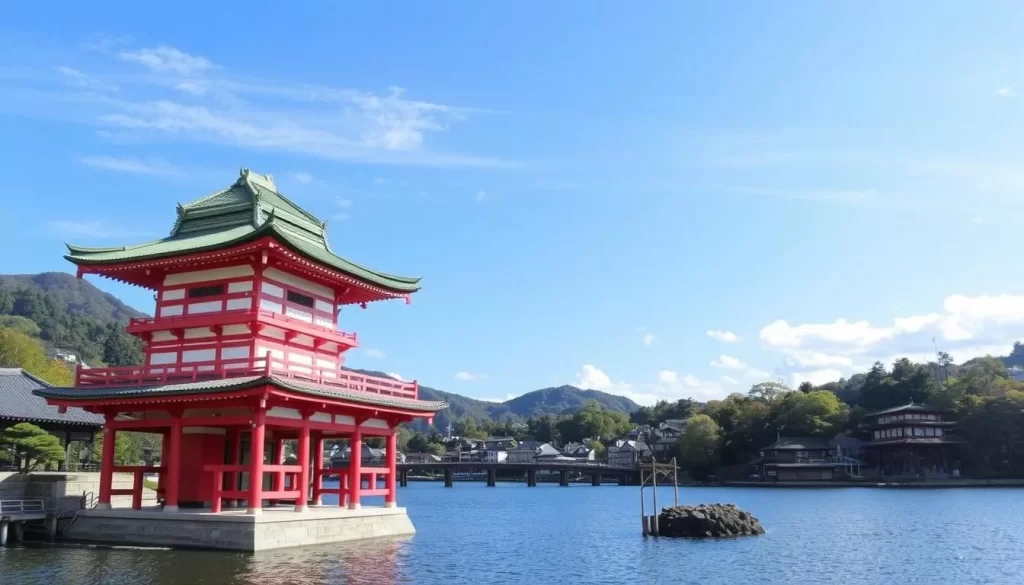
Tottori Prefecture, Japan, is a captivating region that showcases the country’s natural beauty through its changing seasons. With its diverse landscapes, Tottori offers a unique experience for tourists, from the sand dunes to the coastal attractions.
Geographic Location and Unique Features
Tottori Prefecture is located on the coast of Japan, featuring a mix of mountainous areas, coastal lines, and sandy dunes. The region’s varied geography contributes to its distinct weather patterns throughout the year. The famous Tottori Sand Dunes, for instance, are a major attraction that changes appearance with the seasons.
Why Weather Matters When Visiting Tottori
The weather in Tottori significantly impacts the tourist experience, determining the accessibility and enjoyment of various attractions. For example, hiking Mount Daisen is best done during periods of good visibility and moderate temperatures. Similarly, the coastal attractions along the Uradome Coast are most enjoyable when the seas are calm and skies are clear.
Understanding Tottori’s weather patterns and seasonal changes is crucial for planning your trip. The region experiences a rainy season from mid-June to mid-July, and winter brings snow to the mountainous areas. By considering these factors, you can pack appropriately and make the most of your visit to Tottori Prefecture.
Tottori Prefecture, Japan: Best Months for a Weather-Savvy Trip
Tottori’s diverse climate means that the best months to visit vary depending on your preferences and activities. Understanding the seasonal weather patterns can help you plan a more enjoyable and stress-free trip.
Spring (March-May): Cherry Blossoms and Mild Temperatures
Spring is a beautiful time to visit Tottori, with gradually warming temperatures ranging from 10-23°C (50-73°F). The cherry blossoms typically bloom in late March through April, creating picturesque landscapes and comfortable conditions for exploration. During this season, you can enjoy outdoor activities like hiking and sightseeing without the harsh weather conditions of other times of the year.
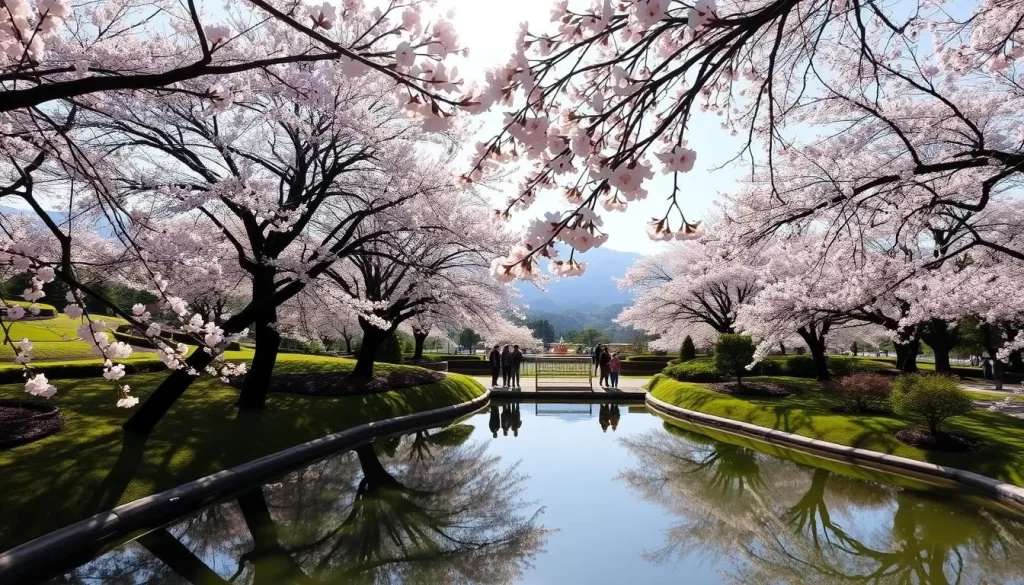
Fall (September-November): Autumn Colors and Pleasant Weather
Fall is another excellent time to visit Tottori, with autumn colors peaking in September and October. The weather cools down from 27°C to 15°C (81-59°F), making it ideal for outdoor activities like hiking and exploring the beauty of nature. With decreasing rainfall, you can enjoy festivals and cultural events without the disruptions caused by rainy season or extreme heat.
At a Glance: Year-Round Weather Patterns
Tottori’s year-round weather follows predictable patterns. Winter (December-February) brings cold temperatures and snow to mountainous areas, while summer (June-August) is hot and humid with a rainy season in June and July. Understanding these patterns allows you to choose the best time for your preferred activities, whether it’s enjoying beach activities in summer or experiencing festivals in fall or spring.
By considering the season and month of your visit, you can make the most of your trip to Tottori Prefecture and enjoy the unique experiences it offers throughout the year.
Spring in Tottori: A Season of Renewal
Spring in Tottori is a time of renewal, bringing with it mild temperatures and breathtaking natural beauty. As the season progresses, the prefecture transforms, offering a variety of experiences for visitors.
March Weather Conditions and What to Pack
In March, Tottori’s weather is transitioning from winter to spring, with temperatures gradually warming up. Daytime temperatures can reach around 12°C (54°F), while evenings remain cool, around 4°C (39°F). It’s essential to pack layers for your trip, including light jackets and comfortable clothing for outdoor activities. You should also be prepared for occasional rain showers.
April: Cherry Blossom Season and Festivals
April is a highlight of spring in Tottori, with the cherry blossom season in full bloom. The prefecture’s parks and gardens are filled with beautiful sakura trees, creating a picturesque landscape. This period also coincides with various festivals, celebrating the arrival of spring. Visitors can enjoy traditional foods, local performances, and cultural events that showcase Tottori’s rich heritage. Some popular spots include Mount Daisen and Uradome Coast, which offer stunning views and pleasant walking trails.
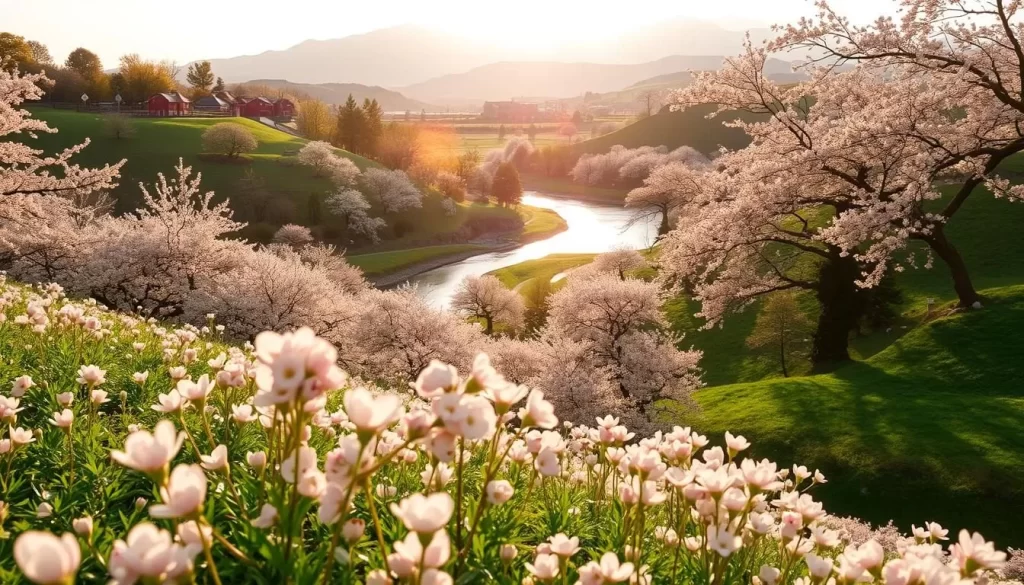
May: Perfect Temperatures for Outdoor Activities
May is considered one of the best times to visit Tottori, with comfortable temperatures ranging from 12°C to 25°C (54°F to 77°F). The stable weather makes it ideal for outdoor activities such as hiking, exploring the sand dunes, or visiting the coast. The lush greenery and blooming flowers add to the natural beauty, making it a photographer’s paradise. You can enjoy traditional spring festivals throughout May, experiencing authentic local culture and cuisine.
- Enjoy pleasant weather with temperatures between 12°C to 25°C (54°F to 77°F).
- Explore Tottori’s natural beauty, from the sand dunes to the Uradome Coast.
- Participate in traditional spring festivals and experience local culture.
- Take advantage of the relatively low tourist numbers after Golden Week.
Summer in Tottori: Beaches and Festivities

As summer arrives, Tottori transforms into a lively destination for travelers. The season brings a mix of warm weather, beautiful beaches, and vibrant cultural events.
June: Pre-Rainy Season Opportunities
In June, Tottori enjoys a pre-rainy season period that is ideal for outdoor activities. The weather is generally mild, making it a great time to explore the Tottori Sand Dunes and enjoy water sports along the coast.
July-August: Managing Heat and Humidity
July and August are the peak summer months in Tottori, characterized by heat and humidity. Despite the weather, these months offer a plethora of experiences, including cormorant fishing demonstrations and various summer festivals. Visitors can enjoy the cool breeze on boat tours along the Uradome Coast, taking in the spectacular views of unique rock formations.
Summer Festivals and Coastal Activities
Summer in Tottori is marked by numerous festivals and coastal activities. The Shan-Shan Festival in August is a highlight, featuring hundreds of dancers performing through the streets of Tottori City. Additionally, the evenings are filled with fireworks displays over the beaches and rivers, creating a magical atmosphere.
Visitors can also enjoy swimming, water sports, and seaside relaxation at the beaches along the Sea of Japan. The summer food festivals celebrate seasonal specialties, offering fresh seafood, watermelon, and other local delicacies.
Fall in Tottori: Nature’s Spectacular Show
As the seasons change, Tottori Prefecture transforms into a breathtaking autumn landscape. The fall season brings a kaleidoscope of colors, exciting outdoor activities, and a serene atmosphere, making it an ideal time to visit this hidden gem in Japan.
September: Transitioning from Summer Heat
In September, Tottori begins its transition from the summer heat, with temperatures gradually cooling down. This period is ideal for those who prefer milder weather, as it’s still warm enough to enjoy outdoor activities without the intense summer sun. You can start experiencing the early signs of autumn, with some trees beginning to change colors.
October-November: Fall Foliage and Harvest Season
The months of October and November are the peak of the fall foliage season in Tottori. The landscape is painted with vibrant colors as the trees turn into shades of orange, red, and yellow. This is also the harvest season, with local produce being celebrated in various festivals and events throughout the prefecture. You can enjoy the picturesque scenery, participate in harvest festivals, and savor the local cuisine.
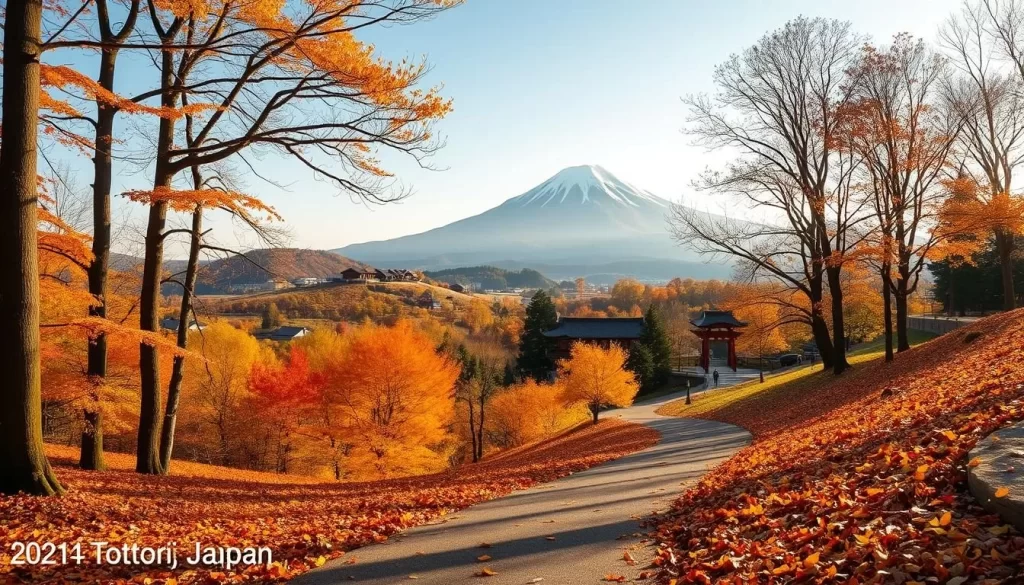
Hiking Mount Daisen in Autumn
Mount Daisen, standing at 1,729 meters, is a must-visit destination during the autumn season. The mountain offers trails for all skill levels, from beginner-friendly paths to more challenging routes. As you hike, you’ll be surrounded by the stunning fall colors, with forests of beech, maple, and other deciduous trees creating a breathtaking display. The panoramic views from the top are rewarding, with visibility often extending to the Sea of Japan and the surrounding countryside.
The best time to hike Mount Daisen is early morning, when the mist rises through the colorful forests, creating a magical atmosphere. You can also spot local wildlife, as many species become more active during autumn, preparing for the winter.
Winter in Tottori: Serene Landscapes and Hot Springs
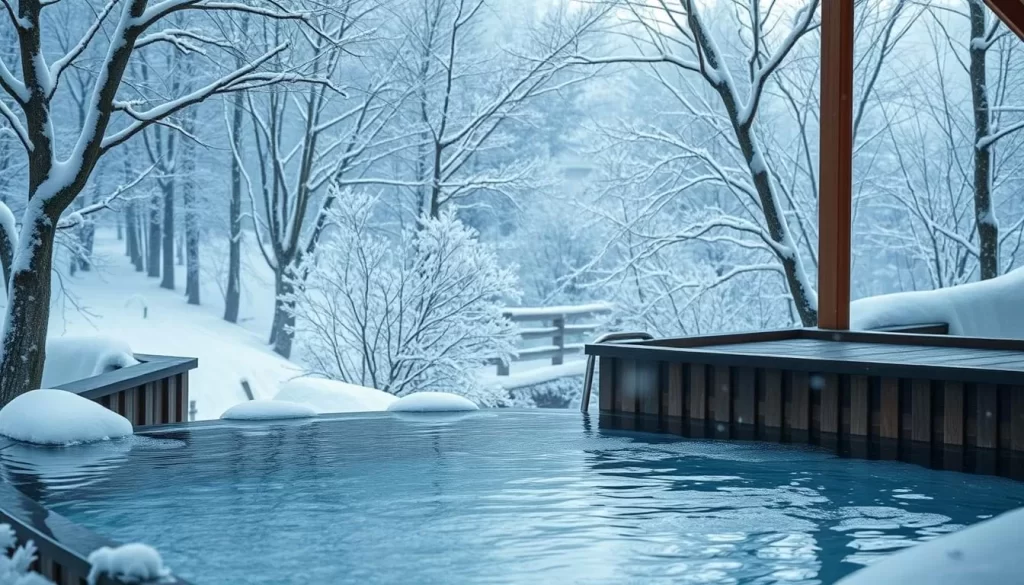
As winter sets in, Tottori Prefecture becomes a haven for those seeking tranquility. The cold weather brings a serene beauty to the landscapes, making it an ideal time for a peaceful getaway.
December-February: Weather Conditions and Snow Activities
During the winter months, Tottori experiences cold weather, with December, January, and February being the coolest months. While it may not be as cold as other parts of Japan, the temperatures can still drop significantly. Visitors can enjoy snow activities in certain areas, although the snowfall is generally not as heavy as in other regions.
The dry weather conditions in December make it a good time to visit Tottori, with plenty of sunshine and minimal crowds. January and February are also good months to visit, with the added beauty of winter landscapes.
Winter Cuisine and Cultural Experiences
Winter is a great time to indulge in Tottori’s local cuisine, which includes fresh seafood and warm, comforting dishes. Visitors can enjoy seasonal delicacies such as hot pot and oysters, which are at their best during the winter months.
Cultural experiences are also available during the winter season, with various festivals and events taking place. Visitors can immerse themselves in local traditions and enjoy the unique atmosphere of Tottori during this time.
Avoiding Tourist Crowds in Winter
One of the advantages of visiting Tottori in winter is the lack of crowds. Popular attractions are much quieter, allowing visitors to enjoy a more peaceful and authentic experience. The Tottori Sand Dunes, for example, become a serene and contemplative space, perfect for solitary walks.
By visiting during the winter weekdays, tourists can avoid the crowds altogether and enjoy a more relaxed pace. This is also a good time to visit popular museums and indoor attractions, such as the Tottori Sand Museum and the Gosho Aoyama Manga Factory, without the long lines.
Must-Visit Attractions Based on Seasonal Weather
Tottori Prefecture’s unique attractions are closely tied to the seasonal weather conditions, making it essential to plan your visit accordingly. Whether you’re interested in outdoor activities or cultural experiences, the prefecture has something to offer in every season.
Tottori Sand Dunes: Best Viewing Times
The Tottori Sand Dunes are a must-visit attraction, particularly during the spring and autumn months when the weather is mild and pleasant. Visiting during these times allows you to fully appreciate the vast, sandy landscape without the harsh conditions of summer or winter. The sand dunes are also a great spot for sunrise and sunset viewing, offering breathtaking vistas.

Uradome Coast: Ideal Weather for Exploration
Uradome Coast is another popular destination, with its rugged coastline and beautiful beaches. The ideal time to visit is during the summer months when the weather is warm, and the sea is calm, making it perfect for swimming and other water activities. However, the coast is also stunning during the autumn season, with the mild weather making it ideal for hiking and exploration.
Cultural Sites and Indoor Attractions for Rainy Days
On rainy days, Tottori Prefecture offers a variety of cultural sites and indoor attractions. You can explore the Tottori Sand Museum, which features intricate sand sculptures by international artists. Traditional hot springs (onsen) like Tottori Onsen and Misasa Onsen are also great places to relax and unwind while enjoying Japanese bathing culture. Additionally, museums like the Watanabe Art Museum offer a glimpse into the region’s rich cultural heritage.
- Visit historic temples like Daisenji, which offer covered areas to appreciate traditional architecture.
- Explore local craft workshops to learn traditional skills like pottery making.
- Enjoy culinary experiences, such as sake brewery tours or traditional tea ceremonies.
- The Gosho Aoyama Manga Factory is a great place for manga fans and families.
Conclusion: Planning Your Weather-Perfect Trip to Tottori
Whether you’re looking for adventure or relaxation, Tottori has a season that’s perfect for you. With distinct experiences throughout the year, this hidden gem offers a unique blend of natural beauty and cultural heritage. To make the most of your trip, consider the best time to visit based on your interests.
For cherry blossom enthusiasts, spring (April-May) is ideal, while summer (July-August) is best for beach lovers. If you prefer milder weather, autumn (October-November) is perfect for enjoying the fall foliage. Winter sports enthusiasts can enjoy January-February. Consider visiting during the shoulder seasons (late May-early June or September-early October) for fewer crowds and more affordable options.
Regardless of when you visit, Tottori’s relatively low tourist numbers ensure an authentic experience of Japan’s culture and beauty. Plan your trip accordingly, and you’ll find that Tottori is a destination that offers something special at any time of year.
The above is subject to change.
Check back often to TRAVEL.COM for the latest travel tips and deals.






